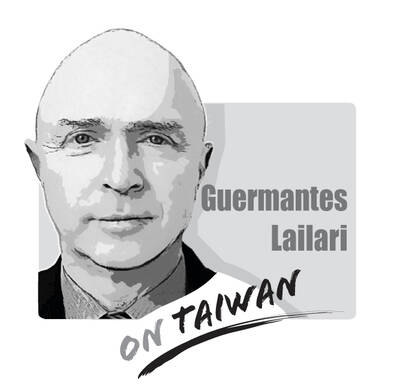The period from former president Lee Teng-hui’s (李登輝) administration from 1988 to 2000 through former president Chen Shui-bian’s (陳水扁) two terms from 2000 to 2008 and President Ma Ying-jeou’s (馬英九) rule since 2008 has reflected political development in the post-president Chiang Ching-kuo (蔣經國) era: The shaky path toward development amid the struggle between Taiwanese localization and Chinese colonialism.
Lee attempted to transform the Chinese Nationalist Party (KMT) into a Taiwanese nationalist party and make the Republic of China (ROC) more Taiwan-centered. In 1999, he proposed the special state-to-state dictum to define relations between Taiwan and China, and this should have been an opportunity for the Chinese colonialist KMT government to get a new lease on life in Taiwan.
However, the stubborn KMT was unable to clearly see the historical trend and made every effort to expel Lee from the party. Since Taiwanese politicians inside the KMT mostly bend with the wind, they were unable to consolidate Lee’s line.
During Chen’s time in office, Taiwanese outside the KMT tried to make the ROC Taiwan-centered using the force of the Democratic Progressive Party (DPP), reiterating that there is “one country on each side” of the Taiwan Strait.
Unfortunately, Taiwanese had been brainwashed for years by the Sinicization ideology that had taken root at every level throughout society. Since the DPP did not hold a legislative majority most of that time, it was blocked repeatedly, while it was unable to convince Taiwanese living abroad to support localization.
Despite Chen’s accomplishments, he was attacked from every direction and failed to consolidate localized rule and was seriously humiliated and tormented after stepping down in 2008.
Ma has been eager to draw a line between his own and Lee and Chen’s 20-year rule by reversing their road toward reconstruction and reform. He has resumed the attitude of the two Chiangs, secretly promoting the colonial nature of the KMT by joining hands with the Chinese Communist Party to control Taiwan.
He is incompetent and extremely evil, and merely shouts slogans about economic development. He hides corruption behind an anti-corruption image, while collusion between government and industry becomes worse and worse, clearly exposing the chaos and failure as the KMT’s collapse became apparent in the nine-in-one local elections in November last year.
The 28-year period from Lee through Chen to Ma — assuming Ma can finish his term — should have been long enough for a country to turn its misfortune into fortune and rise from ruins. The rule of the two Chiangs in Taiwan overlapped with the Martial Law era. If democratization and localization are to be realized in the post-Chiang era, a shared national entity will be formed, and the formation of such a shared community would be a significant historic development.
Unfortunately, some Taiwanese and many Chinese exiles who have not abandoned their Greater China colonialist attitude and refuse to truly identify themselves with Taiwan are not allowing this glorious historic change to take place.
Meanwhile, China is using its newfound economic prosperity and capitalist logic to lure Taiwanese, who attach great importance to the economy.
This is a critical challenge to Taiwan. Without the progressive cultural vision of localization, Taiwan will not be able to follow the road to freedom through to its end.
Lee Min-yung is a poet.
Translated by Eddy Chang
Chinese actor Alan Yu (于朦朧) died after allegedly falling from a building in Beijing on Sept. 11. The actor’s mysterious death was tightly censored on Chinese social media, with discussions and doubts about the incident quickly erased. Even Hong Kong artist Daniel Chan’s (陳曉東) post questioning the truth about the case was automatically deleted, sparking concern among overseas Chinese-speaking communities about the dark culture and severe censorship in China’s entertainment industry. Yu had been under house arrest for days, and forced to drink with the rich and powerful before he died, reports said. He lost his life in this vicious
A recent trio of opinion articles in this newspaper reflects the growing anxiety surrounding Washington’s reported request for Taiwan to shift up to 50 percent of its semiconductor production abroad — a process likely to take 10 years, even under the most serious and coordinated effort. Simon H. Tang (湯先鈍) issued a sharp warning (“US trade threatens silicon shield,” Oct. 4, page 8), calling the move a threat to Taiwan’s “silicon shield,” which he argues deters aggression by making Taiwan indispensable. On the same day, Hsiao Hsi-huei (蕭錫惠) (“Responding to US semiconductor policy shift,” Oct. 4, page 8) focused on

George Santayana wrote: “Those who cannot remember the past are condemned to repeat it.” This article will help readers avoid repeating mistakes by examining four examples from the civil war between the Chinese Communist Party (CCP) forces and the Republic of China (ROC) forces that involved two city sieges and two island invasions. The city sieges compared are Changchun (May to October 1948) and Beiping (November 1948 to January 1949, renamed Beijing after its capture), and attempts to invade Kinmen (October 1949) and Hainan (April 1950). Comparing and contrasting these examples, we can learn how Taiwan may prevent a war with
In South Korea, the medical cosmetic industry is fiercely competitive and prices are low, attracting beauty enthusiasts from Taiwan. However, basic medical risks are often overlooked. While sharing a meal with friends recently, I heard one mention that his daughter would be going to South Korea for a cosmetic skincare procedure. I felt a twinge of unease at the time, but seeing as it was just a casual conversation among friends, I simply reminded him to prioritize safety. I never thought that, not long after, I would actually encounter a patient in my clinic with a similar situation. She had